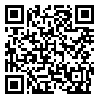Volume 7, Issue 1 (1-2006)
yafte 2006, 7(1): 49-54 |
Back to browse issues page
Abstract: (18369 Views)
Background: Hemorrhagic Transformation of Infarct (HTI) is an important finding
which has been reported mainly in cardio embolic strokes . Although clinical status
of the patients is not often deteriorated , however decision making for anticoagulation
is difficult in HTI patients.
The goal of this survey was to determine the prevalence and the cause of HTI in
patients in the Vali Asr hospital in Khorasan.
Materials and Methods: This descriptive – cross sectional study was carried out in
all of the stroke patients admitted in Valie Asr Hospital, Khorasan from 2001 to 2003.
The HTI was diagnosed by CT scan within 24-48 hours of stroke onset and the arterial
territory of infarct was confirmed by topographic maps of brain in CT. Clinical status
of the patients was evaluated each 12 hours during hospitalization period . Etiologic
work up of our stroke patients were included routine blood chemistry and hematologic
tests , ECG, transthoracic echocardiography and carotid duplex and transcranial
Doppler sonography.
Findings: 26 of 302 stroke patients (13 female and 13 male) or 8.6% had HTI . 88%
of the HTI occurred within MCA territory. The lenticulostriate artery was involved
alone in 46% and with other MCA branches in 23% of cases . In patients with HTI,
clinical status was deteriorated in 15.4% , recovered in 38.5% and stabilized in 46%,
during hospitalization periods respectively.
The cardio embolism consisted 34.6% of etiologies in our HTI patients.
Conclusions: Cardio embolism was not the main etiology in our patients with HTI.
This finding reduces generality of the Fisher– Adams hypothesis. HTI infrequently
leads to clinical deterioration of the patients.
Type of Study: Research |
Received: 2013/01/22 | Accepted: 2021/10/13 | Published: 2006/01/15
Received: 2013/01/22 | Accepted: 2021/10/13 | Published: 2006/01/15
| Rights and permissions | |
 |
This work is licensed under a Creative Commons Attribution-NonCommercial 4.0 International License. |


